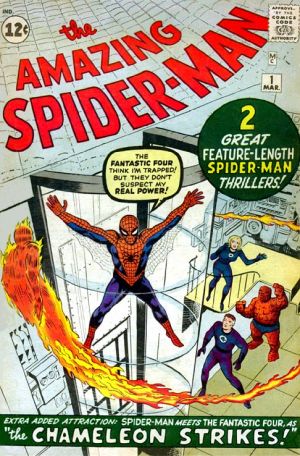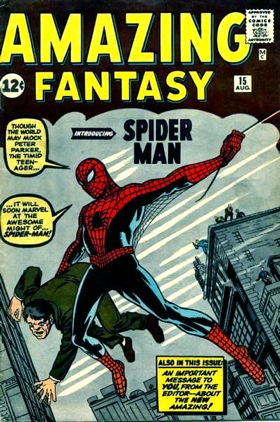Comics /
Spotlight /
Progressive Panels
Amazing Fantasy (1962) #15 at 50
By Andy Frisk
July 11, 2012 - 10:35
Although
The Fantastic Four (1961) #1 was published first, it was
Amazing Fantasy (1962) #15 that really solidified Marvel Comics’ legacy as the most innovative, realistic, and popular publisher of comic book stories. The Fantastic Four were a family of squabbling superheroes who battled wild and crazy super-sci-fi villains and whose stories epitomized the type of sci-fi that characterized the early days of the Atomic Age. The Fantastic Four, unique as they were-being a team of superheroes who weren’t established as solo characters first and brought together to battle greater evils a la The Justice League-were still a team of heroes lead by a wise and slightly older leader (Mr. Fantastic/Reed Richards) who sort of kept the hotheaded teenager Johnny Storm/The Human Torch and the short tempered strong man Ben Grimm/The Thing in line. The superhero introduced in
Amazing Fantasy (1961) #15 was a completely new and daring character though. Peter Parker was the ultimate high school aged bookworm who was verbally abused by his peers at school, but who still had the confidence to ask girls out while striving to live up to the doting, but golden hearted, expectations of his Aunt May and Uncle Ben. Peter Parker wasn’t perfect though. He dreamed, “someday I’ll show them!-sob-Someday they’ll be sorry that they laughed at me!” as he made his way to the fateful radiation demonstration that would accidentally endow him with his spider-centric superpowers. Once he got that power though, he learned that “with great power comes great responsibility.” The phrase coined by Stan Lee would become one of the most widely known and admired superhero mantras of all time, just like The Amazing Spider-Man would become one of the most widely known and admired superheroes of all time.
It didn’t take long for Spider-Man, as portrayed in
Amazing Fantasy (1962) #15, to get his own series:
The Amazing Spider-Man (1963), It also didn’t take long for him to find widespread appeal, of all places, amongst college aged young adults of the 1960s. “In 1965, an Esquire magazine poll of college students ranked Spider-Man as one of their favorite revolutionary icons, along with Bob Dylan. Asked why, one interviewee reportedly picked Spider-Man because he was "beset by woes, money problems, and the question of existence. In short, he was one of us." (see quotation source
here) I imagine this reaction to Spider-Man couldn’t have been more welcomed by Stan Lee. Stan the Man set out to create a superhero that was young, active, fallible, honest, good hearted, not a sidekick to an older hero a la Robin over at DC Comics, and most of all relatable to. Spider-Man was a kid without answers, real life problems, and the power to stand up to the elements of the system that were corrupt or unjust. Even more intelligently though, Spider-Man reflected the burgeoning movement to not just war against the system, but to use the system against itself to inspire change or at least change one’s station in life. Peter Parker, desperately trying to help his widowed Aunt May meet her financial needs, goes to work for J. Jonah Jameson, the publisher of one of the most anti-Spider-Man hate mongers in the Marvel U’s New York City, selling pictures of himself as Spider-Man and profiting off of them. He is using his talent as a photographer and as a superhero to care for his Aunt May honestly and thoughtfully. How easy would it be for someone like Peter Parker’s powers to set themselves up on easy street? No, the “great power/great responsibility” aspects of the character extended beyond just the super heroics. Life itself is full of opportunities to exercise great power for good or evil, and Peter decided to do it the hard way: the right and greatly responsible way.
 |
Peter Parker/Spider-Man was someone that millions of young adults could relate to not just because of his real life problems and battles, but because often times he was really only accepted and understood by those who were his peers. At the end of
The Amazing Spider-Man (1963) #1, after tussling with the Fantastic Four, Reed Richards, Sue Storm, and Ben Grimm all express their doubts about whether or not Spider-Man will prove to be a trustworthy comrade or future threat. Only Johnny Storm, The Human Torch and a teen of the same age as Peter Parker/Spider-Man states, “Aw, we won’t ever hafta worry about him!” They would both go on to become very close friends over the years. Also, Peter Parker’s most unforgiving bully, Flash Thompson a fellow student of Peter’s at Midtown High, would become Spider-Man’s biggest fan. The young adults in Peter Parker/Spider-Man’s life all understood and rooted for Spider-Man, much like the real world readers of
The Amazing Spider-Man comic books would. It would be Spider-Man’s appeal to young adults and teenagers that would keep the character fresh and ever ripe for rediscovery by the next generation of young people verging on the cusp of adulthood.
So much would Spider-Man appeal to this demographic that 50 years later,
Amazing Fantasy (1962) #15 is still one of the modern age’s defining works of not only sequential art, but pop-art in general. Millions of kids still thrill to the animated and live action filmed adventures of Spider-Man on the both the small and big screens, while millions of adults, both young and old, continue to thrill to Spider-Man comic books, novels, and graphic novels. Here’s to another 50 years of The Amazing Spider-Man, his spectacular stories, and the lessons on responsibility that he reintroduces to each new generation.
Last Updated: January 17, 2025 - 08:20

